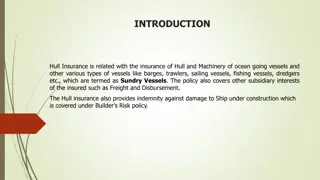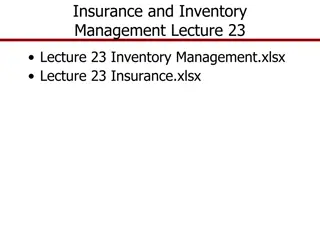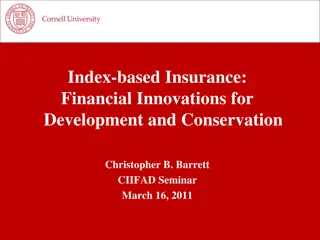Overview of Subrogation in Marine Insurance and Principles of Indemnity
Subrogation in marine insurance involves the substitution of one person for another in terms of rights and duties. This process is crucial in ensuring indemnity principles are upheld. The doctrine of subrogation plays a significant role in various insurance contracts, excluding those related to life insurance and personal accident coverage. Key legal cases and principles further illustrate the application of subrogation in insurance law.
Uploaded on Sep 19, 2024 | 0 Views
Download Presentation

Please find below an Image/Link to download the presentation.
The content on the website is provided AS IS for your information and personal use only. It may not be sold, licensed, or shared on other websites without obtaining consent from the author. Download presentation by click this link. If you encounter any issues during the download, it is possible that the publisher has removed the file from their server.
E N D
Presentation Transcript
AIDA Working Party Sessions Marine Insurance: Subrogation under Australian/English Stuart Hetherington President, Comit Maritime International Partner, Colin Biggers & Paisley
CMIFounded in 1897 Raison d etre Uniformity Principal Conventions drafted: Collision Arrest Bills of lading Salvage Limitation conventions and many others Custodian of the York Antwerp Rules
CMI and Marine Insurance Marine Insurance Act 1906 (UK)/Marine Insurance Act (1909) Australia CMI Conference 1994 International Working Groups: Professor John Hare: International Review of Marine Insurance: Duty of good faith Duty of disclosure Alternation of risk Warranties See report in Yearbook 2004
CMI and Marine Insurance Dieter Schwampe: Mandatory insurance under International Conventions: CLC HNS Bunkers Wreck Removal Athens Protocol of 2002 (i) Licensing of insurers (ii) Recognition of certificates issued by other States (iii) Direct action availability (iv) State liability eg where insurer not financially stable
Subrogation Professor Sutton: Subrogation may be described in broad terms as the substitution of one person for another, so that the same rights and duties as attached to the original person attach to the substituted one. It is a transfer of rights from one person to another without assignment or the assent of the person from whom the rights are transferred, which takes place by operation of law in a whole variety of widely differing circumstances .
Principles of indemnity: The principles governing indemnity are therefore bound up with the doctrine of subrogation and indeed are complementary to it. This leads to the position that, for example, contracts of life insurance and many contracts of personal accident insurance...because they are not contracts of indemnity, the law of subrogation has no application.
Leading High Court decision: British Traders Insurance Co Ltd v Monson [1964] 111 CLR 86. Santos Ltd v American Home Assurance Co [1986] 4 ANZ Ins Cas 60- 795, Supreme Court of South Australia, White J listed the conditions precedent to the exercise of rights of subrogation as: (a) That the insurance was indemnity insurance (b) That payment by the insurer had been made under it; and (c) That the insurer s rights of subrogation had not been excluded by a term of the parties contract.
Sutton describes two distinct rights which are conferred: First, the right to oblige the assured to pursue a new remedy he or she may have against a third party for the benefit of the insurer; and secondly, the right to recover from the assured any benefit received by the assured in diminution or extinction of the loss for which he or she has been indemnified.
Marine Insurance S.85 Marine Insurance Act (1909) (S.90 Marine Insurance Act 1906 (UK)) 85(1) Where the insurer pays for a total loss, either of the whole, or in the case of goods of any apportionable part, of the subject matter insured, he thereupon becomes entitled to take over the interest of the assured in whatever may remain of the subject matter so paid for, and he is thereby subrogated to all the rights and remedies of the assured in and in respect of that subject matter as from the time of the casualty causing the loss.
Recovery Proceeds Castellain v Preston [1883] 1 QBD 380: Brett LJ The very foundation, in my opinion, of every rule which has been applied to insurance law is this, namely, that the contract of insurance contained in a marine or fire policy is a contract of indemnity, and of indemnity only, and that this contract means that the assured, in case of a loss against which the policy has been made, shall be fully indemnified, but shall never be more than fully indemnified North of England Iron Steamship Insurance Association v Armstrong [1870] LR 5 QB 244: The insurer could keep any amount recovered, even if it exceeds the insured value.
Rejected by Diplock J in Yorkshire Insurance Co Ltd v Nisbet Shipping Co Ltd [1962] 2 QB 330. However, in Lord Napier & Ettrick & Anor v Hunter and Ors [1993] 1 AER 385 the House of Lords was critical of Diplock J s reasoning based on purely contractual reasoning and failing to apply equitable principles. Recoveries made by the Lloyds names from managing agents were found to be held in trust for stop loss insurers. The names were not entitled to be compensated in respect of their excesses before the stop loss insurers had been fully indemnified. Decision applies to the excess (or deductible).
Lord Templeman Set out the argument: Say a hypothetical Lloyd s name suffered a loss of 160,000; excess was 25,000 and limit 100,000 by stop loss insurers. Stop loss insurers paid 100,000. Names sued the managing agent of their syndicate Outhwaite for negligence and recovered 116M. For the purposes of argument treated as holding 130,000 attributable to the loss of 160,000 by Name. Lord Templeman examined that position as if the Name had insured himself as follows: (1) 25,000 with first insurer (2) 100,000 with second insurer (3) 125,000 plus with third insurer.
On suffering loss of 160,000 he would recover: (1) 25,000 under first policy (2) 100,000 under second policy (3) 35,000 under third policy Damages payable by Outhwaite 130,000 would then be distributed as follows: (1) Third insurer gets its 35,000 because it only agreed to pay if first two did not cover total loss (2) Second insurer gets 95,000 because it only agreed to pay if first cover was insufficient. So: Second insurer has a loss of 5,000 and first insurer has a loss of 25,000 Name should not be better off if decided not to insure and self insured.
Australian Law: ALRC (1982) recommended that Diplock J s decision in Nisbett be reversed. This occurred in s.67 of Insurance Contracts Act (1984) (Cth): "67. Rights with respect to moneys recovered under subrogation (1) Where an insurer, in exercising a right of subrogation in respect of a loss, recovers an amount, the insured may recover that amount from the insurer. (2) Unless the contract expressly provides otherwise, the insured may not recover under subsection (1):
(a) an amount greater than the amount (if any) by which the amount recovered by the insurer exceeds the amount paid to the insured by the insurer in relation to the loss; or (b) an amount that, together with the amount paid to the insured under the contract, is greater than the amount of the insured's loss. (3) The rights of an insured and insurer under the preceding provisions of this section are subject to any agreement made between them after the loss occurred. (4) A reference in this section to an amount recovered by an insurer shall be construed as a reference to the amount so recovered less the administrative and legal costs incurred in connection with the recovery of the amount. i.e. Insurer keeps profits.
This does not apply to marine (except pleasure craft not used for commercial purposes). However ALRC Rep No. 91 April 2001 into Marine Insurance suggested adoption of s.67 but in an amended form. The explanatory memorandum to the recent Amendment Bill to the Insurance Contracts Act (1984) describes the principles thus: 1. The party taking a recovery action should be entitled to reimbursement for the administrative and legal costs of that action from any monies recovered. 2. There are three possibilities for distribution of remaining sums depending on who has funded the recovery action:
(a) If the insurer funds the recovery action pursuant to its rights of subrogation it is entitled to an amount equal to the amount that it has paid to the insured under the contract of insurance. The insured is then entitled to any further amount necessary for it to ultimately recover from the insurer under the contract of insurance or the third party in the recovery action, or both in combination, the full amount of its loss (not just the measure of indemnity under the policy). (b) If the insured funds the recovery action the order in the preceding paragraph is reversed. The insured is entitled to retain an amount so that the total it receives from the recovery action and under the policy is equal to its total loss. The insurer is entitled at this point to an amount equal to the amount that it has paid to the insured under the insurance contract.
(c) If the action is funded jointly by both the insurer and the insured, they are both entitled to the same amounts as referred to in (a) and (b) above pro-rata if there are insufficient funds to reimburse them in full. 3. Any excess or windfall recovery is then to be distributed to both parties in the same proportions as they contributed to the administrative and legal costs of the recovery action. 4. Any separate or identifiable component in respect of interest should be divided fairly between the parties having regard to the amounts that each has recovered and the periods of time for which each party lost the use of their funds.
5. These rights may be modified by the terms of the relevant insurance contract and the rights apply, in accordance with the same principles, whether the person being indemnified is the insured party or a third party beneficiary to whom the indemnity cover extends. The recent amendments to the Insurance Contracts Act 1984 (Cth) have adopted those changes, and are attached to the paper. They come into force at the end of this year.























